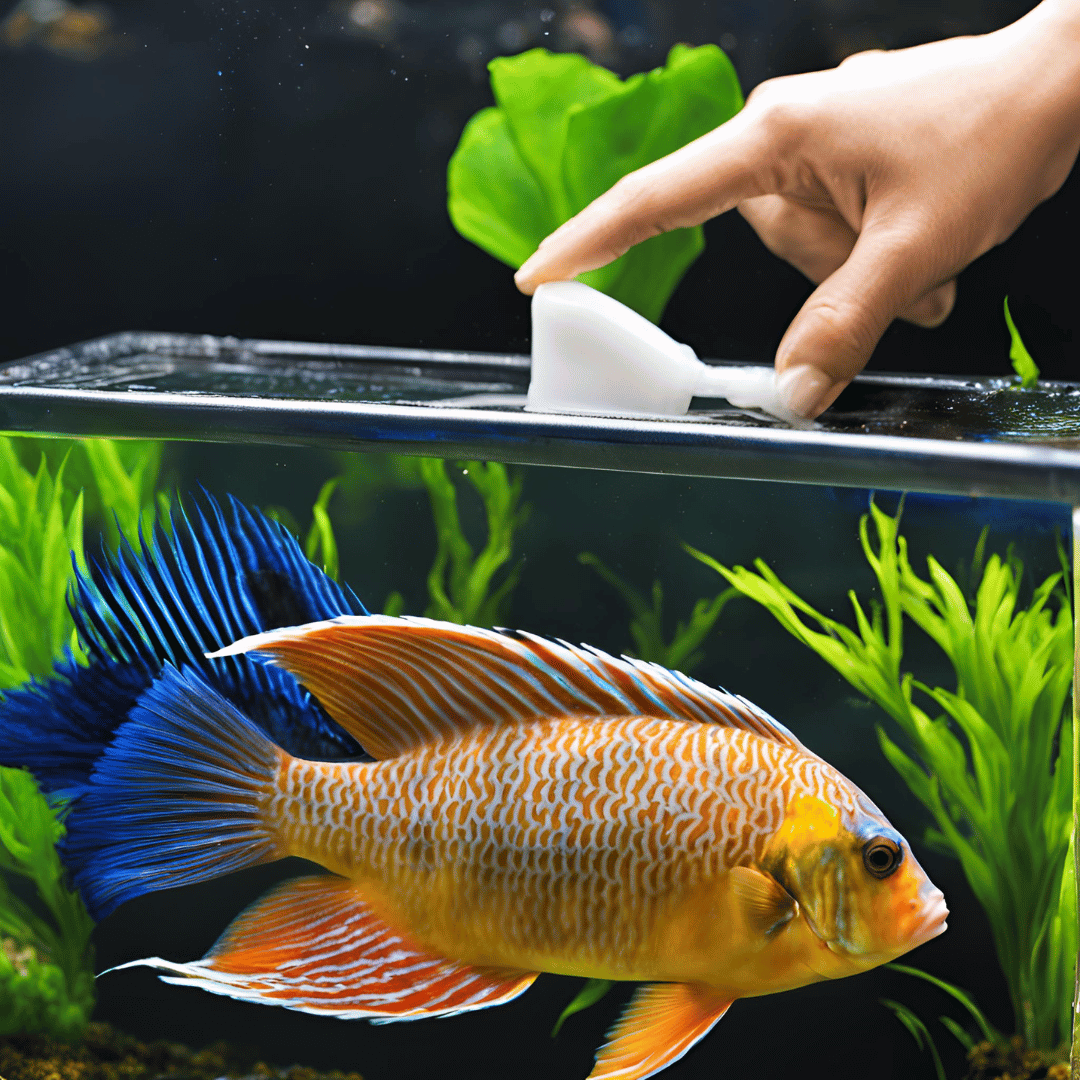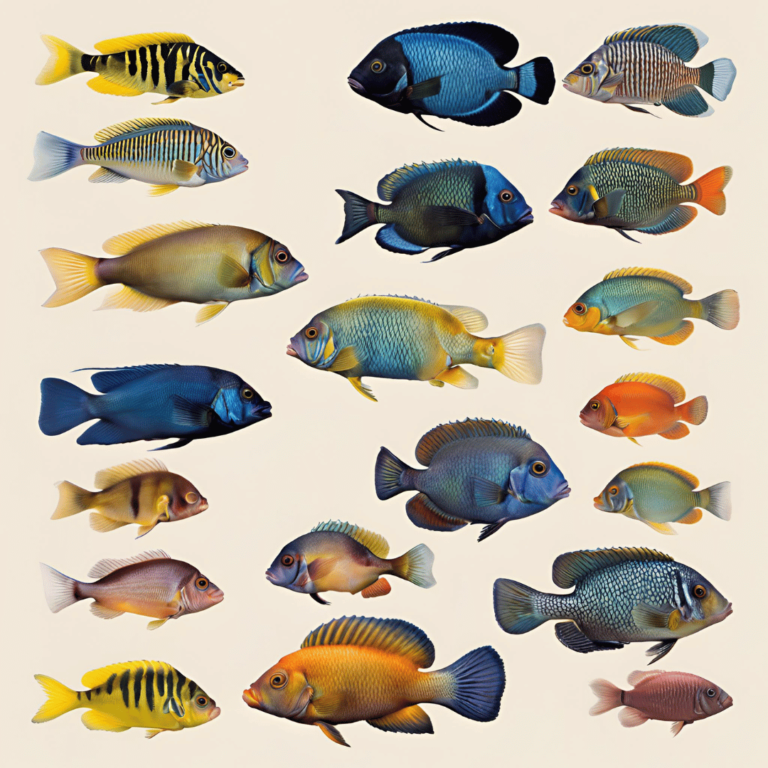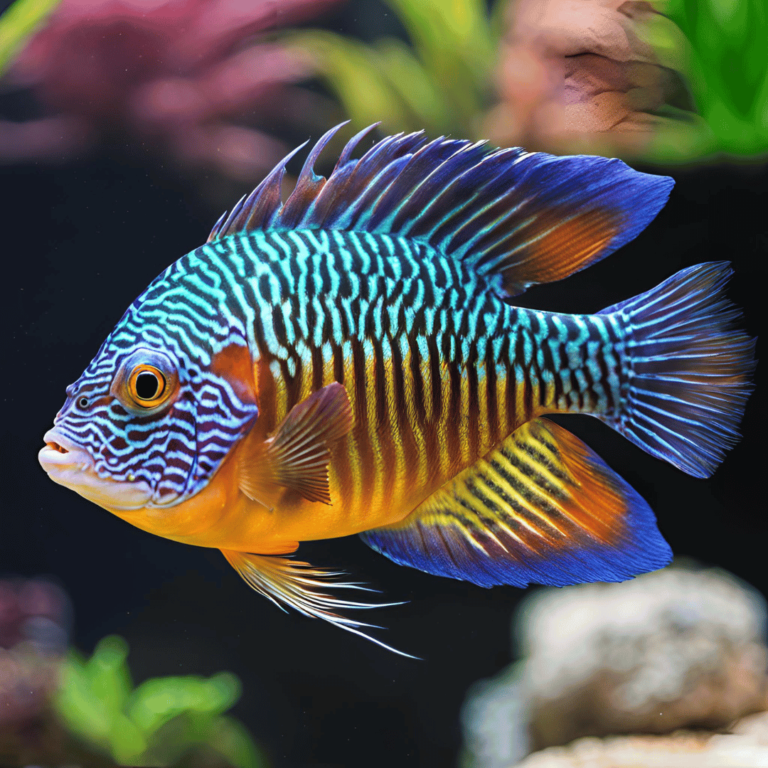Your trusted guide to cichlid care, tank setups, and quality products.

Peacock Cichlid Tank Cleaning: 7 Best Tools & Expert Tips
Keep your peacock cichlid tank sparkling clean with our expert guide! Learn the best cleaning practices and essential tools to maintain optimal water quality and a healthy environment for your fish.
Image Credits Canva
Peacock cichlids are known for their vibrant colors and lively behavior, making them a favorite choice among aquarists. To maintain their health and beauty, one of the most crucial aspects of care is peacock cichlid tank cleaning. A clean tank not only improves water quality but also ensures that your fish thrive in a stress-free environment. But how do you clean a peacock cichlid tank efficiently without stressing the fish? What tools should you use? In this comprehensive guide, we’ll walk you through the best practices and tools to keep your peacock cichlid tank spotless and healthy.
At PeacockCichlid.com, we believe in transparency and honesty with our readers. Some of the links in this article are affiliate links, which means we may earn a small commission if you make a purchase through them—at no additional cost to you. These commissions help support our site, allowing us to continue providing expert advice, in-depth guides, and valuable content for Peacock Cichlid enthusiasts like you.
We only recommend products that we trust and believe will be beneficial for your aquarium. Thank you for your support!
Why Peacock Cichlid Tank Cleaning is Essential
A clean tank is more than just visually appealing. Peacock cichlids are sensitive to changes in water quality, and a buildup of waste, uneaten food, and algae can quickly deteriorate water conditions. Regular peacock cichlid tank cleaning helps maintain water quality and prevents harmful bacteria from accumulating.
In addition, a well-maintained tank minimizes the chances of diseases and stress, keeping your peacock cichlids active and healthy. Proper tank maintenance allows their natural colors to shine and ensures their lively personalities remain intact.
Best Practices for Peacock Cichlid Tank Cleaning
Cleaning your peacock cichlid tank should be done regularly and systematically to ensure your fish remain healthy. Below are the best practices to follow for effective peacock cichlid tank cleaning:
1. Establish a Routine Maintenance Schedule
Consistency is key when it comes to maintaining a clean tank. Setting up a routine schedule ensures that cleaning tasks are manageable and do not overwhelm you or your fish.
- Weekly Tasks: Perform partial water changes (10-20%), lightly vacuum the substrate, and check the filter for clogs.
- Monthly Tasks: Inspect equipment such as the filter, heater, and lighting. Deep clean decorations and conduct a thorough gravel vacuum.
- Annual Tasks: Deep clean the tank, replace old equipment, and refresh cleaning tools as needed.
Regular maintenance keeps the tank’s ecosystem stable and ensures your peacock cichlids stay stress-free.
2. Partial Water Changes: The Key to Water Quality
Regular partial water changes are one of the most important steps in peacock cichlid tank cleaning. They help stabilize water parameters, remove toxins, and replenish essential minerals.
How to Perform a Partial Water Change:
- Use a siphon or gravel vacuum to remove 10-20% of the tank water.
- Clean the substrate while removing debris and waste.
- Replace the water with clean, dechlorinated water at the same temperature as the tank.
Pro Tip: Avoid full water changes unless absolutely necessary, as they can disrupt the balance of beneficial bacteria and shock your fish.
3. Gravel Vacuuming: Keep the Substrate Clean
The substrate in your tank acts as a collection point for uneaten food, fish waste, and debris. Since peacock cichlids sift through the substrate, keeping it clean is essential.
Gravel Vacuuming Tips:
- Use a gentle gravel vacuum to clean without removing too much water.
- Vacuum the substrate in sections to preserve beneficial bacteria colonies.
A clean substrate improves water quality and prevents harmful bacteria growth.
4. Cleaning Decorations to Prevent Algae Build-Up
Aquarium decorations, such as rocks, caves, and driftwood, are not just aesthetic—they also provide hiding spots for peacock cichlids. However, they can trap debris and become breeding grounds for algae and bacteria.
How to Clean Decorations:
- Remove decorations from the tank.
- Rinse them with warm water and scrub with a soft brush to remove algae.
- Avoid using soap or detergents, as these can leave harmful residues.
Cleaning decorations regularly ensures your tank remains visually appealing and safe for your fish.
5. Filter Maintenance for Optimal Water Quality
The filter is the heart of your peacock cichlid tank cleaning routine. It removes debris, waste, and toxins while maintaining the tank’s nitrogen cycle. Regular maintenance ensures it functions effectively.
Filter Cleaning Tips:
- Check the filter weekly for clogs.
- Rinse filter media in tank water to preserve beneficial bacteria.
- Avoid cleaning the filter with tap water, as chlorine can kill helpful bacteria.
Keeping the filter clean helps maintain stable water conditions and supports your fish’s health.
6. Managing Algae Growth in Your Peacock Cichlid Tank
Algae are a natural part of any aquarium, but excessive growth can make your tank look dirty and unhealthy. Controlling algae is an essential part of peacock cichlid tank cleaning.
Algae Control Tips:
- Limit the tank’s exposure to direct sunlight.
- Reduce the duration of artificial lighting.
- Avoid overfeeding your cichlids, as uneaten food can contribute to algae growth.
- Use an algae scraper or magnetic cleaner to remove algae from tank walls.
Keeping algae in check helps maintain a clean and healthy environment.
7. Monitoring Water Parameters Regularly
Stable water conditions are critical for peacock cichlids, as they thrive in specific water parameters. Regularly testing water quality ensures your tank remains a healthy home for your fish.
Water Testing Tips:
- Use a comprehensive water test kit to monitor pH, ammonia, nitrite, and nitrate levels.
- Maintain a pH between 7.8 and 8.6 for peacock cichlids.
- Add crushed coral to the substrate or use buffers to keep the pH stable.
Monitoring water parameters helps you identify potential issues early and adjust your cleaning routine accordingly.
Recommended Tools for Peacock Cichlid Tank Cleaning
Using the right tools makes peacock cichlid tank cleaning easier and more effective. Here are some must-have items:
- Gravel Vacuum or Siphon: Essential for partial water changes and substrate cleaning.
- Algae Scraper or Magnetic Cleaner: Helps remove algae from tank walls.
- Filter Cleaning Brush: Cleans filter components without damaging them.
- Water Conditioner: Dechlorinates tap water before adding it to the tank.
- Aquarium Test Kit: Monitors water quality and ensures parameters remain stable.
Investing in quality tools ensures a hassle-free cleaning routine and a healthier tank.
How to Clean a Peacock Cichlid Tank Without Stressing Your Fish
Cleaning your peacock cichlid tank should be as stress-free as possible for your fish. Here are some tips:
- Don’t Remove the Fish: Leave your cichlids in the tank during cleaning to avoid unnecessary stress.
- Clean in Sections: Divide the tank into sections and clean one part at a time to minimize disruptions.
- Be Gentle and Quiet: Avoid sudden movements and loud noises that could startle your fish.
- Use Appropriate Tools: Magnetic cleaners and gravel vacuums let you clean efficiently without disturbing your fish too much.
Conclusion
Regular peacock cichlid tank cleaning is essential for maintaining a healthy and vibrant aquarium. By following these best practices and using the recommended tools, you can create a stress-free environment where your peacock cichlids thrive. Partial water changes, substrate cleaning, and filter maintenance are the cornerstones of a clean tank. Combine these with regular monitoring of water parameters and algae control, and your tank will remain a beautiful, healthy home for your fish.
If you found this guide helpful, share it with other peacock cichlid enthusiasts. Proper peacock cichlid tank cleaning is the foundation of successful fish care, and spreading knowledge helps everyone keep their fish happy and healthy.
If you found these cleaning tips useful, be sure to explore more of our expert advice on maintaining a pristine environment for your Peacock Cichlids. Check out our article Peacock Cichlid Tank Maintenance: 14 Proven Tips for Success for a deeper dive into daily upkeep strategies, and learn how to keep your water in optimal condition with Peacock Cichlid pH Stability: 10 Powerful Steps for Success. Don’t miss Top 10 Mistakes to Avoid When Keeping Peacock Cichlids for essential insights on sidestepping common pitfalls in aquarium care.
We invite you to visit peacochcichlid.com again soon for more tips and updates, and be sure to follow us on social media to stay connected with the latest in aquarium inspiration!
FAQ’s
How often should I clean my peacock cichlid tank?
It’s best to perform partial water changes and light substrate cleaning weekly. Deep cleaning decorations and inspecting equipment should be done monthly, while a comprehensive checkup and replacement of old equipment can be done annually. Following this schedule ensures your peacock cichlids thrive in a clean and healthy environment.
Can I use the same cleaning methods for other cichlids?
Yes, many of the cleaning techniques for peacock cichlid tank cleaning can also be applied to tanks housing other cichlids. However, always research the specific requirements of each species to cater to their unique needs, such as different water parameters or substrate preferences.
Do I need to remove my peacock cichlids while cleaning the tank?
No, it’s better to leave your fish in the tank during cleaning to reduce stress. Removing them unnecessarily can cause undue stress and potential injury. Clean in sections to minimize disturbances and ensure their environment remains stable.
How do I prevent algae growth in my peacock cichlid tank?
To control algae, limit the tank’s exposure to sunlight, reduce artificial lighting duration, and avoid overfeeding your fish. Additionally, you can incorporate algae-eating species compatible with peacock cichlids or use tools like algae scrapers during regular cleaning. Maintaining proper water quality also reduces excessive algae growth.
What water parameters are ideal for peacock cichlids?
Peacock cichlids thrive in water with a pH range of 7.8 to 8.6, a temperature between 76°F and 82°F, and low ammonia, nitrite, and nitrate levels. Stable water parameters are crucial to their health, so regular testing and adjustments are necessary to maintain these conditions.
Are the cleaning tools for peacock cichlids suitable for other cichlids?
Yes, tools like gravel vacuums, algae scrapers, and filter cleaning brushes are versatile and can be used for tanks with other cichlid species. Ensure the tools are cleaned between uses to prevent cross-contamination and meet the specific requirements of each tank.
How can I clean tank decorations effectively?
Remove decorations from the tank and rinse them under warm water. Use a soft brush to scrub away algae and debris. Avoid using soap or detergents, as these can leave harmful residues. Regular cleaning of decorations keeps your tank looking beautiful and safe for your peacock cichlids.
Why is partial water change important for peacock cichlids?
Partial water changes stabilize water parameters, remove toxins, and replenish essential minerals that might have been depleted over time. This practice ensures your fish live in a clean and healthy environment while minimizing the risk of stress and disease.
Can cleaning the filter harm beneficial bacteria?
Rinsing filter media in tank water instead of tap water preserves beneficial bacteria, which are essential for breaking down toxins like ammonia and nitrites. Avoid using chlorinated water, as it can kill these helpful microorganisms and disrupt the nitrogen cycle.
How do I clean the substrate without disturbing the peacock cichlids?
Use a gravel vacuum to clean the substrate gently, focusing on one section at a time. This method minimizes disruptions to your fish and preserves beneficial bacteria colonies. Regular cleaning prevents waste buildup and maintains water quality, ensuring a healthy habitat for your peacock cichlids.



